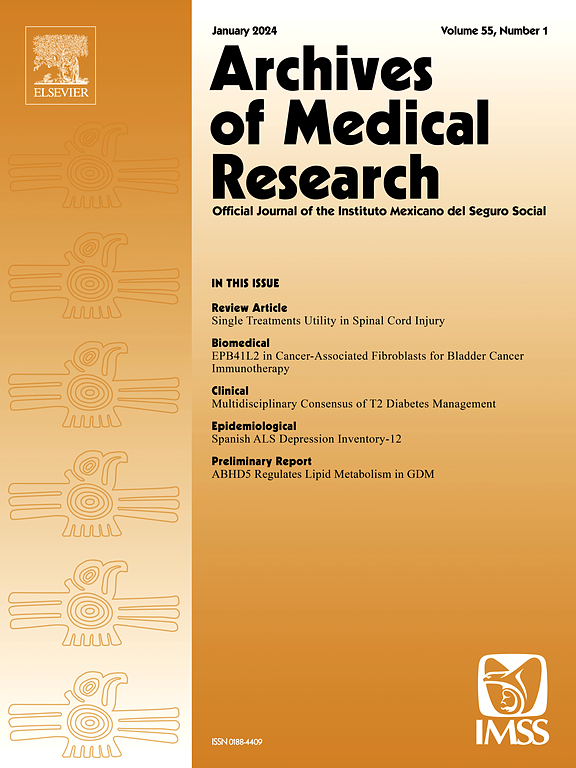血浆血清素作为儿童和超重/肥胖中注意缺陷多动障碍严重程度的生物标志物
IF 3.4
3区 医学
Q1 MEDICINE, RESEARCH & EXPERIMENTAL
引用次数: 0
摘要
背景和目的近年来,血浆血清素浓度作为多种疾病的生物标志物的潜在应用已被报道。然而,血浆血清素水平是否对诊断注意缺陷多动障碍(ADHD)有用仍有争议。评估5-羟色胺(5-HT, 5-羟色胺)作为学龄期儿童ADHD诊断、严重程度和超重/肥胖的生物标志物。方法89例学龄儿童(对照组20例,ADHD患儿69例:多动症17例,注意力不集中26例,混合型26例)进行分析。使用Kruskal-Wallis测试,分别比较ADHD存在、严重程度和肥胖的游离5-羟色胺(5-HTF)和血小板5-羟色胺(5-HTP)水平。多元回归模型评估5-HTF和5-HTP对ADHD存在和严重程度的预测价值,调整年龄和肥胖。使用logistic回归的比值比(OR)和曲线下面积(AUC)评估5-HTF的诊断效用。结果ADHD患者5-HTF水平明显升高。亚组间无显著差异,但5-HTF水平随ADHD严重程度升高。在超重/肥胖患者中也观察到较高的5-HTF水平。5-HTP呈相反趋势,尽管不那么明显。Logistic回归显示,5-HTF每升高0.1 μ mol/L, ADHD几率增加71%。ADHD严重程度的or值分别为8.77(重度)、2.31(中度)和0.45(轻度)。5-HTF诊断ADHD的AUC为0.76,诊断中度/重度ADHD的AUC为0.93。结论血浆5-HTF浓度可作为ADHD诊断、严重程度及与超重/肥胖合并症的有用生物标志物。本文章由计算机程序翻译,如有差异,请以英文原文为准。
Plasma Serotonin as a Biomarker of the Severity of Attention Deficit Hyperactivity Disorder, in Children and Overweight/Obesity
Background and Aims
Recently, the potential use of plasma serotonin concentration as a biomarker for various diseases has been reported. However, whether plasma serotonin levels are useful for diagnosing attention deficit hyperactivity disorder (ADHD) remains controversial. To evaluate 5-hydroxytryptamine (5-HT, serotonin) as a biomarker for ADHD diagnosis, its severity, and overweight/obesity in school-aged children.
Methods
Eighty-nine school-aged children (20 controls and 69 with ADHD: 17 hyperactive, 26 inattentive, and 26 mixed) were analyzed. Free 5-HT (5-HTF) and platelet 5-HT (5-HTP) levels were compared for ADHD presence, severity, and obesity, respectively, using the Kruskal-Wallis test. Multiple regression models assessed the predictive value of 5-HTF and 5-HTP for the presence and severity of ADHD, adjusting for age and obesity. The diagnostic utility of 5-HTF was evaluated using odds ratios (OR) and area under the curve (AUC) from logistic regression.
Results
Patients with ADHD exhibited significantly elevated 5-HTF levels. No significant subgroup differences were found, but 5-HTF levels increased with ADHD severity. Higher 5-HTF levels were also observed in patients with overweight/obesity. Inverse trends were noted for 5-HTP, though less pronounced. Logistic regression showed a 71 % increase in ADHD odds for each 0.1 µmol/L rise in 5-HTF. ORs for ADHD severity were 8.77 (severe), 2.31 (moderate), and 0.45 (mild). The AUC for 5-HTF was 0.76 for ADHD diagnosis and 0.93 for moderate/severe ADHD.
Conclusions
Plasma 5-HTF concentration can be a useful biomarker for the ADHD diagnosis, its severity, and comorbidity with overweight/obesity in these patients.
求助全文
通过发布文献求助,成功后即可免费获取论文全文。
去求助
来源期刊

Archives of Medical Research
医学-医学:研究与实验
CiteScore
12.50
自引率
0.00%
发文量
84
审稿时长
28 days
期刊介绍:
Archives of Medical Research serves as a platform for publishing original peer-reviewed medical research, aiming to bridge gaps created by medical specialization. The journal covers three main categories - biomedical, clinical, and epidemiological contributions, along with review articles and preliminary communications. With an international scope, it presents the study of diseases from diverse perspectives, offering the medical community original investigations ranging from molecular biology to clinical epidemiology in a single publication.
 求助内容:
求助内容: 应助结果提醒方式:
应助结果提醒方式:


